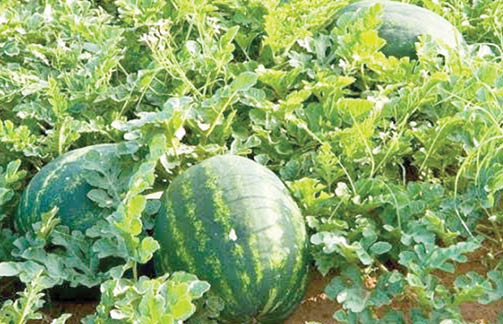Watermelon is a popular fruit in Nigeria and grown mostly by smallholder farmers in the North. Although it is widely consumed across the entire country, there are no large scale farmers compared to South Africa and Kenya.
Golden Harvest puts together these tips for your consideration.
Recommended VARIETIES: some of the varieties grown in Nigeria include sugar baby, kaolack, crimson sweet, black boy and sugar sweet.
‘Sugar Baby’ takes about 80 days to mature and produces 10-pound melons with bright red flesh. This variety of smaller fruit can be planted just 4 feet apart.
‘Sweet Beauty’ also takes about 80 days to mature for harvest. However, there are several varieties grown outside the country.
STARKE AYRES advised farmers to consider the following elements before putting seeds in the ground:
Climatic Requirements
Optimum germination temperature: 27-32°C, with night temperature not lower than 24°C. Optimum growth temperatures at night are 18-20°C, and day 24-30°C, and for ripening 15- 25°C. 2.2
Soil Requirements
Watermelons can be grown on a wide range of soil types although sandy soils are preferred. The highest yields will generally be produced on well-drained sandy-loam soils. Heavy clay soils, soils with obstructed drainage, or very shallow soils should be avoided. Soil pH should be about 5.8-6.2 (H2O). It is usually recommended to lime soil with pH values below 5.5 (H2O)
Soil Preparation
The soil must be thoroughly and deeply cultivated to obtain a good root system. This allows optimal use of moisture and helps to prevent soil-borne diseases. The roots develop at a depth of 30-40cm and the soil structure at that level must be optimal. Soils must be free draining to below 1.2m.
Plant Population And Spacing
A general spacing of between 4,000 to 8,000 plants per hectare is recommended.
Seedling Production
The seed of triploid watermelons is notoriously sensitive to very specific conditions during germination, as the tiny embryo is contained in a relatively large, hard seed coat. Temperature and moisture control is crucial to success, and too much moisture during germination can kill the seed. Due to the higher seed cost, and since the outside climate is very difficult to control or predict, it is highly recommended to have seedlings from a reputable nursery.
Transplanting Seedlings
Seedlings must be transplanted and watered as soon as possible after they have been obtained from the nursery. Planting trays should be kept cool and moist in the shade until used. When transplanting, roots should not be damaged by the application of unnecessary pressure around the root module. Soil should be watered into contact with the roots rather than pressed in.
Fertilization
Watermelons are reasonably sensitive to salt, displaying a 50% yield reduction in the range of EC 4-6 (mMhos/cm at 25 C). Consult a fertilizer or soil specialist on other remedies needed in terms of a soil sample result.
Pests/Diseases
Aphids, Cucumber Beetles. Squash Vine Borer Moths and Fusarium Wilt.
Some of these diseases can be treated early through close monitory of the farm with chemicals recommended by extension experts.
Due for harvest? This is how you will know
STARKE AYRES says watermelon maturity can be determined by a combination of indicators:
External fruit rind colour, buttery-yellow colour of the ground spot.
Various stages of floral bract (leaf) and tendril drying out near the fruit peduncle.
Dull sound when thumped.
Slight cracking sound internally, when the whole fruit is pressed.
Internal flesh colour should be properly developed and characteristic of the cultivar.
Brix with a minimum refractometer reading of 9° Brix can indicate maturity.
Taste samples throughout the field to confirm acceptable harvest indicators.
Watermelons should be harvested in the early morning, as hot fruit respires much more rapidly and leads to over-ripe fruit on delivery.
Cut the stem about 2-4 cm long; do not pull fruit from vines.
The longer stems make it more difficult for rots to enter the watermelon.
Regular sanitation of knives and pruning scissors is essential.
Harvested fruit should be kept under shade and transported to the pack house or market within the shortest possible time to prevent the fruit temperature from rising and minimise moisture loss.

 Join Daily Trust WhatsApp Community For Quick Access To News and Happenings Around You.
Join Daily Trust WhatsApp Community For Quick Access To News and Happenings Around You.


